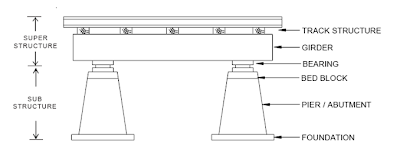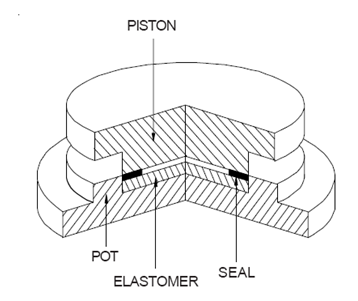Bridges typically consist of two components: the superstructure and the substructure. The superstructure is subject to various dimensional deformations due to the nature of loads placed upon it. These deformations could include:
- Thermal expansion/contraction
- Elastic deformation under live load
- Seismic forces
- Creep and shrinkage of concrete
- Settlement of supports
- Longitudinal forces – tractive/ breaking
- Wind loads
The nature of these forces makes it necessary to have a device in between the substructure (base) and the superstructure which allows for the required movement, while also giving stability and having the capacity to bear the loads placed on the bridge. The device most popularly used, is a bridge bearing which assumes the functionality of a bridge by allowing translation and rotation to occur while supporting the vertical loads.
Thus, a bridge bearing is an element of the superstructure which provides a vital interface between the superstructure and substructure.
PTFE (Teflon) in Bearing Uses in Large Structures
The use of PTFE in such bearings has been steadily increasing, although its application does not extend to all variants of bridge and structural bearings.
PTFE has an exceptionally low coefficient of friction and high self-lubricating characteristics, resistance to attack by almost any chemical, and an ability to operate under a wide temperature range.
Furthermore, while unmodified PTFE can be used to a PV value of only 1,000, PTFE filled with glass fibre, graphite, or other inert materials, can be used at PV values up to 10,000 or more. In general, higher PV values can be used with PTFE bearings at low speeds where its coefficient of friction may be as low as 0.05 to 0.1.
The low coefficient of friction exhibited by PTFE is unique for two primary reasons:
- PTFE against stainless steel exhibits an even lower coefficient of friction that PTFE against PTFE. In fact, the coefficients of PTFE against steel have been found to be the lowest between any two solid materials
- The coefficient reduces with increased pressure – allowing for coefficients as low as 0.03 (See table 1)
To summarise, the following properties have driven the increased application of filled grade PTFE:
- PTFE against steel has one of the lowest coefficients of friction
- The load bearing capacity of the PTFE sheet is in the range of 130-140Kg/cm2
- The PV values are found to be in excess of 10,000
- Service temperatures of -250 to +250°C are possible
PTFE is most commonly used in two types of structural bearings:
PTFE Sliding bearings: A system of two plates, one sliding over the other makes one of the simplest types of bearings. These bearings permit translation in longitudinal and transverse directions, unless specifically restrained in any of these directions. No rotation is permitted unless specially provided in the form of articulation and only vertical loads are resisted / transmitted by these bearings.
Generally, plain sliding bearings are provided where span is less than 30m, because the movement capacity of these bearings is usually small.
The bearing is composed of two thick sheets of steel (preferably high-density carbon steel). Between the sheets are one layer of PTFE (with suitable fillers) and one layer of polished stainless steel. The stainless steel is welded to one of the bearing plates while the PTFE is bonded to the other plate. To provide for better bonding, a recess is created on the bearing plate into which the PTFE is fitted.
Their regular maintenance is very important, to keep a tab on friction otherwise the value of horizontal force transmitted to sub-structure will increase tremendously. Therefore, the frequency of lubrication has been prescribed as once in three years.
POT-PTFE Bearings: These consist of a circular non-reinforced rubber-pad (elastomer) fully enclosed in a steel pot. The rubber is prevented from bulging by the pot walls and it acts similar to a fluid under high pressure.
While the bearings were initially created without PTFE, the necessity of horizontal movement in addition to load bearing capacity made it necessary to incorporate PTFE on the piston. The rotation, therefore, is provided by the elastomer due to differential compression and translation by steel and PTFE.
POT bearings offers a much higher degree of movement than standard sliding bearings, although it is tougher to manufacture due to the extended recess needed for the POT as well as the sealing elements needed to contain the elastomer within the POT. These seals must be metallic. The PTFE plate must be recessed into the piston and requires ‘dimples’ into which additional lubricants are placed during time of installation.
Typical working conditions for standard POT-PTFE bearings include:
- Provisions apply for temperature ranges of -10°C to +50°C
- POT bearing of diameter up to 1500 mm are within scope of these specifications
- Rotation up to 0.025 radians only considered
- PTFE can withstand bearing pressures in excess of 40MPa – depending on the filler used(See table 2)
Designing PTFE structural bearings
Various design codes exist for structural bearings and most of them prescribe similar materials to be used and have similar requirements regarding the grade and strength of the materials. In India the code book for POT-PTFE bearings is the IRC:83 (Part II) while for sliding bearings, there is no system as yet established (although the IRC:83 does refer to the sliding arrangement requirements for POT-PTFE bearings, which can be adopted for all sliding bearings as well). Globally, standards such as the BS:5400 and AASHTO exist for sliding bearings and POT bearings.
The prescribed loads on the PTFE (Teflon) material are more or less uniform across the different codes. Designing the bearing requires an understanding of what the PTFE material can withstand and calculating the sizes and thicknesses of the steel members around this.
Ultimately however, the bearing manufacturer undertakes the responsibility to design the bearings based on customer specifications. In our own experience, it is rare that the same sliding bearing arrangement has ever been used in two separate projects. This illustrates the uniqueness of the PTFE bearing and places a huge onus on the manufacturer to ensure that they capture all elements of the material’s capabilities when designing a new bearing.



